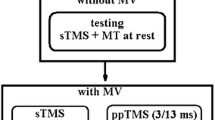Summary
To examine the effects of hand-arm vibrating tool operation on the central and peripheral nervous system, the brainstem auditory-evoked potential (BAEP), median nerve conduction velocity and hearing level were measured in twelve chain saw operators (6 operators had a history of white finger attack) and in eight brush saw operators (none had a history of the attack). Control subjects, matched to each chain saw and brush saw operator by sex and age, were selected randomly from healthy adults without otitis, deafness and tinnitus. The I–V interpeak latency (conduction from cochlear nerve to brainstem) and V peak latency of BAEP were significantly prolonged in chain saw operators; the I–V interpeak latency was significantly correlated with working years in brush saw operators. The median nerve conduction velocity was significantly slowed in both chain saw and brush saw operators. Moderate hearing loss was observed in the two groups. It is suggested that vibrating tool operation, i. e. the combined stressors of local vibration, noise, climate and heavy work, affected not only the peripheral nervous system but also the brainstem portion of the auditory pathway; the brainstem effect, if any, is less advanced than the peripheral nervous system effect of local vibration.
Similar content being viewed by others
References
American National Standards Institute (1969) American national standard specifications for audiometers, Section 3.6. ANSI, New York
Araki S, Yokoyama K, Aono H, Murata K (1988) Determination of the distribution of nerve conduction velocities in chainsaw operators. Br J Ind Med 45:341–344
Arikawa K, Shirakawa T, Kotorii T, Shima M, Nakazawa Y, Inanaga K, Kuwahara H (1978) An electroencephalographic study of patients with vibration disease. Folia Psychiat Neurol Jap 32:211–222
Attias J, Pratt H (1984) Auditory evoked potentials and audiological follow-up of subjects developing noise-induced permanent threshold shift. Audiology 23:498–508
Coats AC, Martin JL (1977) Human auditory nerve action potentials and brainstem evoked responses. Arch Otolaryngol 103:605–622
Dupuis H, Gemne G (1985) Hand-arm vibration and the central nervous system: report from an international symposium. Int Arch Occup Environ Health 55:185–189
Futatsuka M, Teruya H, Harada M, Matsumura K, Goto T (1974) Electroencephalographic studies on forestry workers using vibrating tools (in Japanese). Clin Electroenceph 16:690–694
Futatsuka M (1984) Epidemiological studies of vibration disease due to brush saw operation. Int Arch Occup Environ Health 54:251–260
Futatsuka M, Sakurai T, Ariizumi M (1984) Preliminary evaluation of dose-effect relationships for vibration induced white finger in Japan. Int Arch Occup Environ Health 54:201–221
Gemne G, Taylor W (eds) (1983) Hand-arm vibration and the central autonomic nervous system. Multi-Science Publishing Co, London
Hawkins JE Jr, Johnsson L-G (1976) Patterns of sensorineural degeneration in human ears exposed to noise. In: Henderson D, Hamernik RP, Dosanjh DS, Mills JH (eds) Effects of noise on hearing. Raven Press, New York, pp 91–110
Heinonen E, Farkkila M, Forsstroem J, Antila K, Jalonen J, Korhonen O, Pyykko I (1987) Autonomic neuropathy and vibration exposure in forestry workers. Br J Ind Med 44:412–416
Hitora T (1977) Clinico-physiological studies on Raynaud's phenomenon in chain saw users: central nervous lesion (in Japanese with English abstract). J Nara Med Assoc 28:26–44
Iki M (1984) Noise-induced deafness among forestry workers using vibrating tools (in Japanese with English abstract). J Sci Labour 60:215–222
Kriss A (1982) Stimulation techniques and recording problems. In: Halliday AM (ed) Evoked potentials in clinical testing. Churchill Livingstone, Edinburgh, pp 45–70
Kusunose Y, Harada N, Koga K (1984) A study of the somatosensory evoked potentials on vibration disease: using mechanical stimulation by pin-prick (in Japanese). Clin Electroenceph 26:727–730
Matoba T, Kusumoto H, Omura H, Kotori I, Kuwahara H, Takamatsu M (1975) Digital plethysmographic responses to auditory stimuli in patients with vibration disease. Tohoku J Exp Med 115:385–392
Matoba T, Chiba M, Sakurai T (1985) Body reactions during chain saw work. Br J Ind Med 42:667–671
Morest DK, Bohne BA (1983) Noise-induced degeneration in the brain and representation of inner and outer hair cells. Hearing Res 9:145–151
Murata K, Araki S, Aono H (1987) Assessment of central and peripheral nerve functions in chain-saw operators: a study of short-latency somatosensory evoked potential and peripheral nerve conduction. Tohoku J Exp Med 151:25–31
Murata K, Araki S, Aono H (1987) Effects of lead, zinc and copper absorption on peripheral nerve conduction in metal workers. Int Arch Occup Environ Health 59:11–20
Murata K, Araki S, Aono H (1987) Visual and brainstem auditory evoked potentials in lead-exposed workers (in Japanese with English abstract). Jpn J EEG EMG 15:16–21
Ohta Y, Fujimoto O, Nanno H, Asao H, Fujii H (1985) Study of somatosensory evoked response (SER) in patients with occupational vibration disease (in Japanese with English abstract). Jpn J Ind Health 27:318–326
Pyykko I (1986) Clinical aspects of the hand-arm vibration syndrome: a review. Scand J Work Environ Health 12:439–447
Pyykko I, Starck J (1982) Vibration syndrome in the etiology of occupational hearing loss. Acta Otolaryngol [Suppl] 386:296–300
Pyykko I, Starck J, Farkkila M, Hoikkala M, Korhonen O, Nurminen M (1981) Hand-arm vibration in the aetiology of hearing loss in lumberjacks. Br J Ind Med 38:281–289
Sasaki H, Kikuoka H, Emoto M, Nanjo K, Miyamura K (1987) Auditory brainstem responses and electroencephalographic findings in patients with occupational vibration disease (in Japanese with English abstract). Jpn J Ind Health 29:136–144
Stockard JJ, Stockard JE, Sharbrough FW (1986) Brainstem auditory evoked potentials in neurology: methodology, interpretation, and clinical application. In: Aminoff MJ (ed) Electrodiagnosis in clinical neurology. Churchill Livingstone, New York, pp 467–503
Tanabe T, Kameda M (1979) Somatosensory evoked potential and nerve conduction velocity in vibration disease (in Japanese). Clin Electroenceph 21:324–328
Author information
Authors and Affiliations
Rights and permissions
About this article
Cite this article
Murata, K., Araki, S. & Aono, H. Central and peripheral nervous system effects of hand-arm vibrating tool operation. Int. Arch Occup Environ Heath 62, 183–188 (1990). https://doi.org/10.1007/BF00379429
Received:
Accepted:
Issue Date:
DOI: https://doi.org/10.1007/BF00379429




